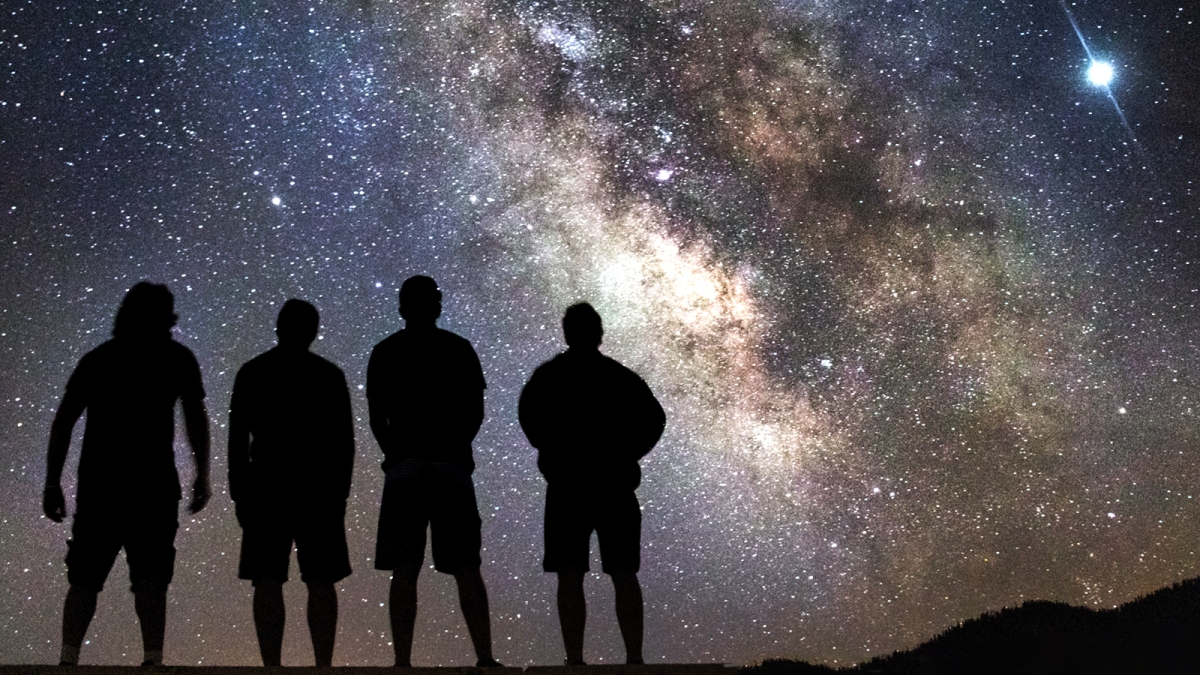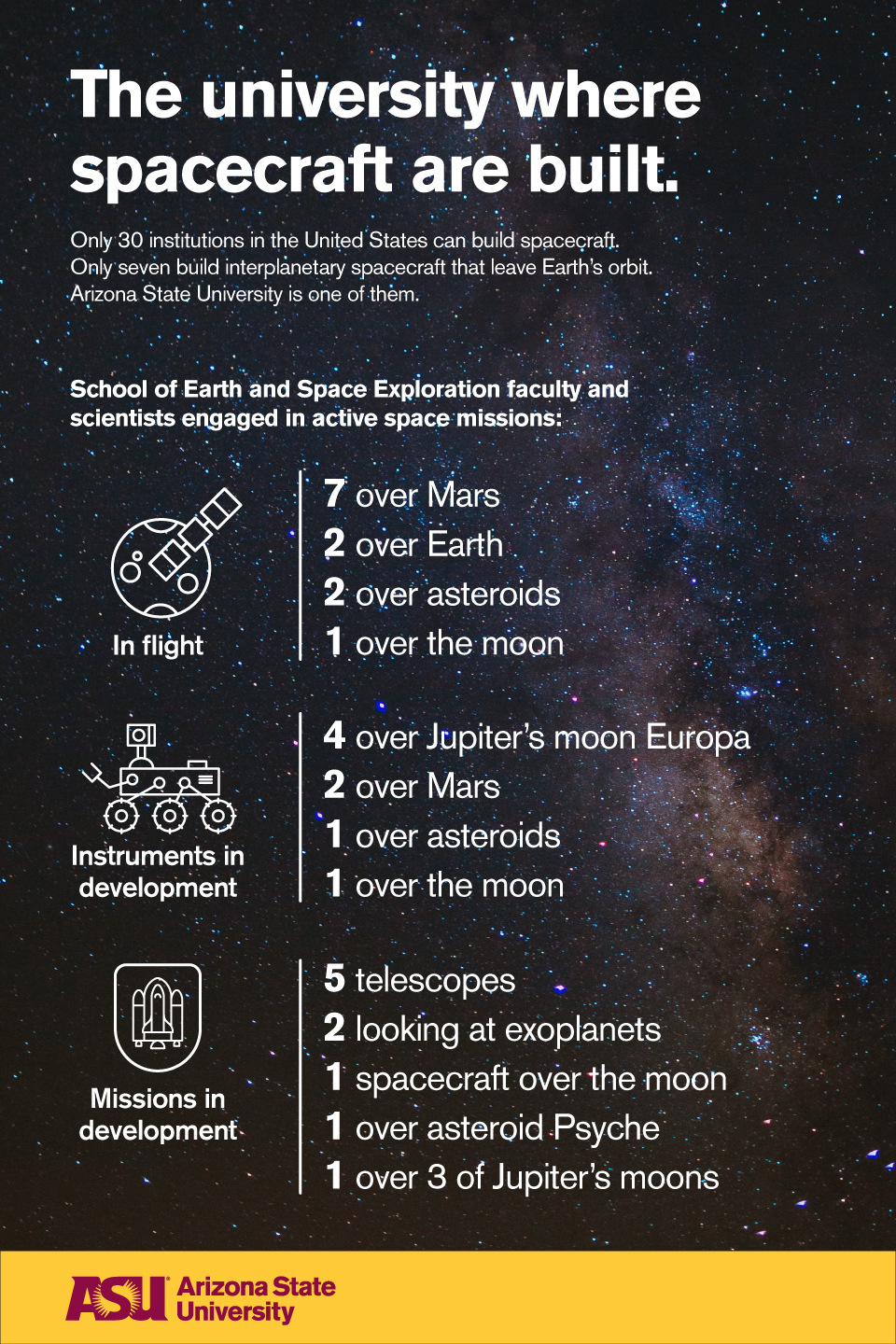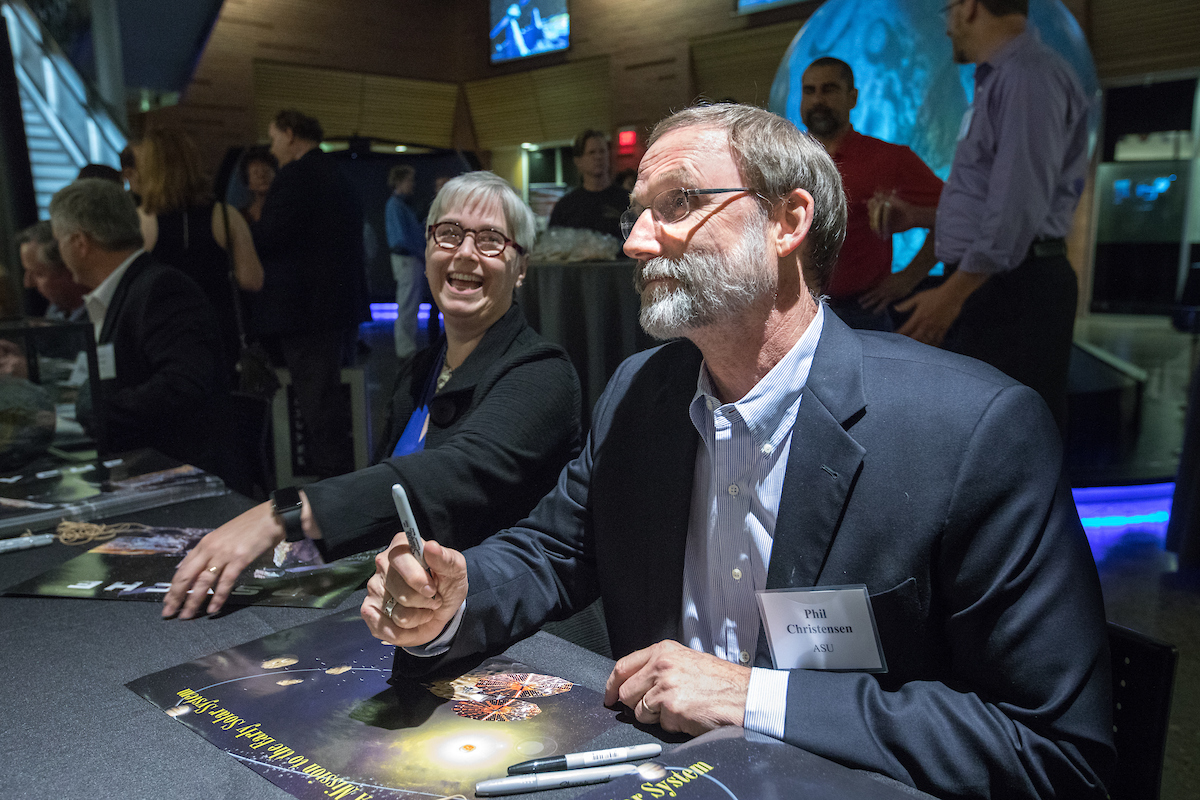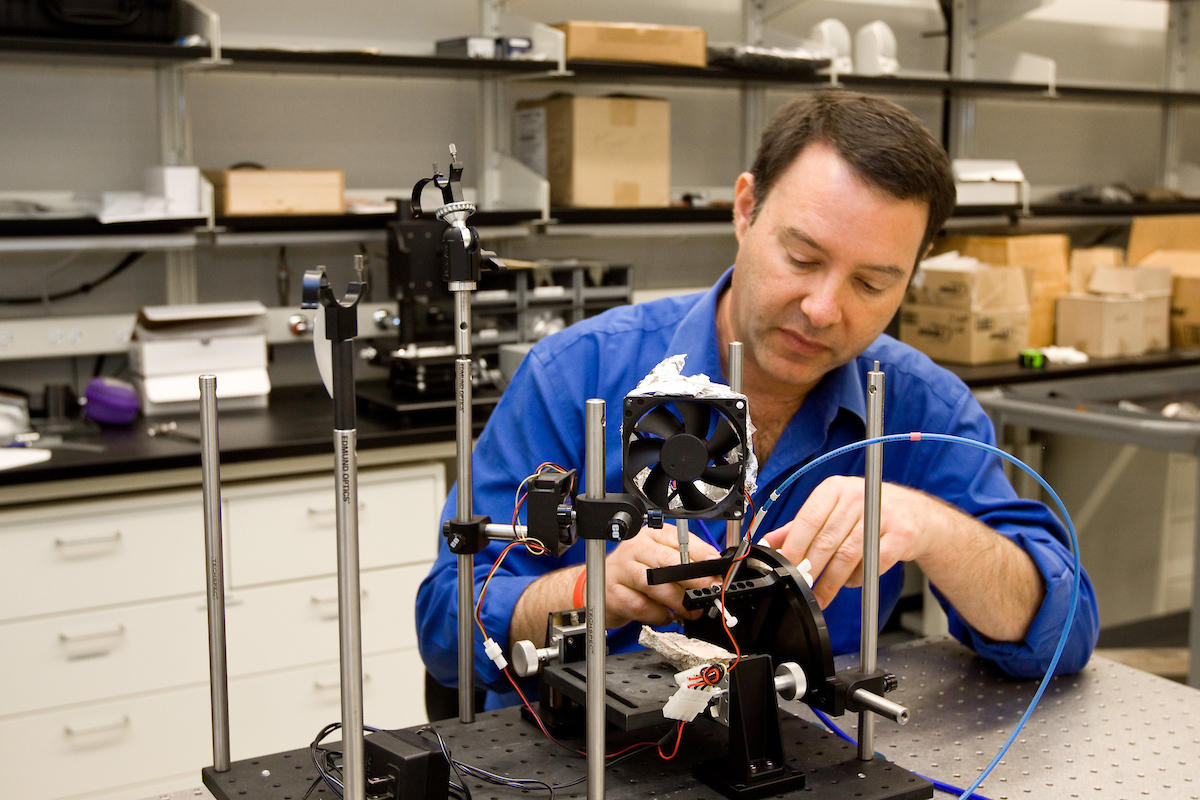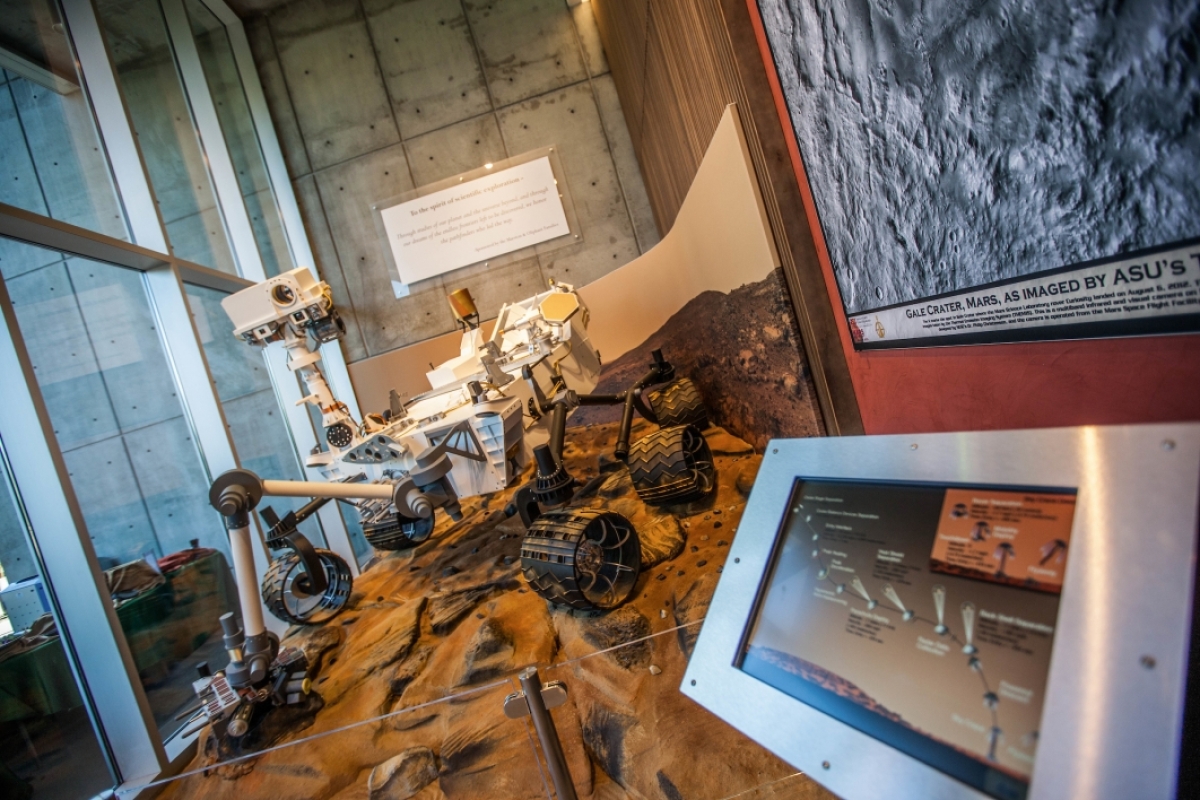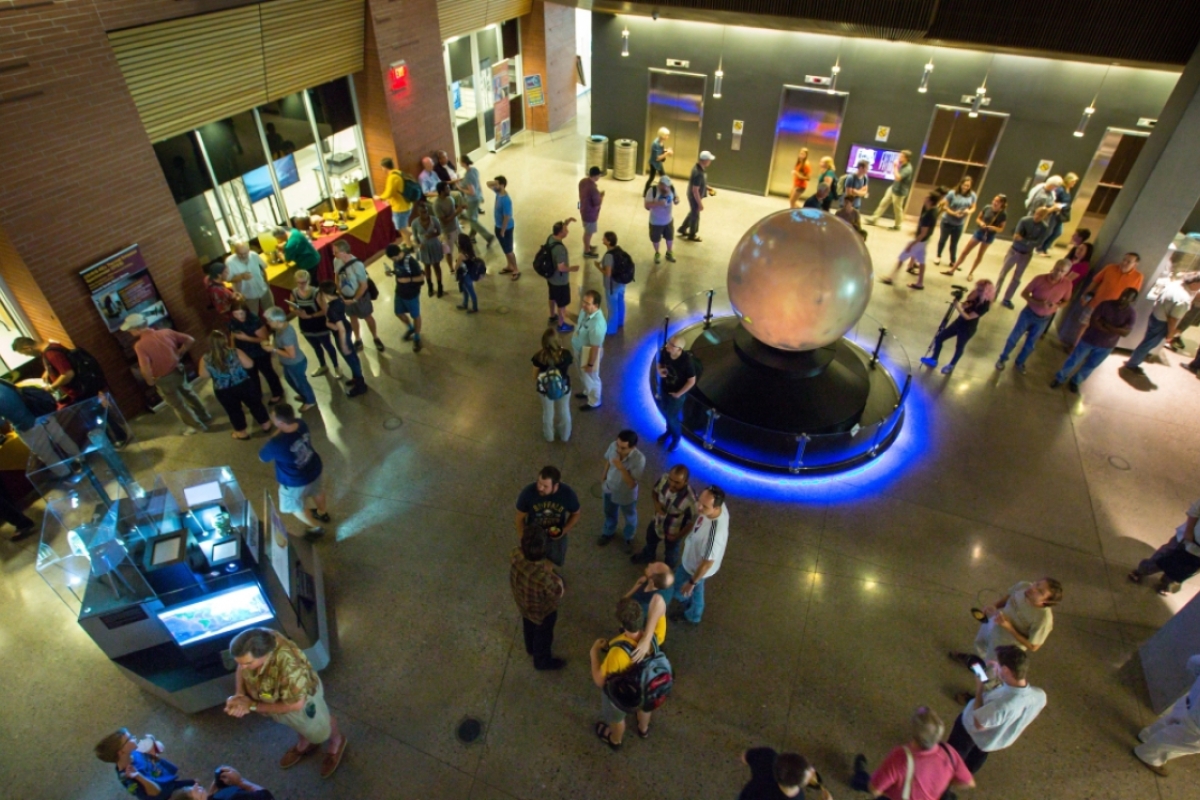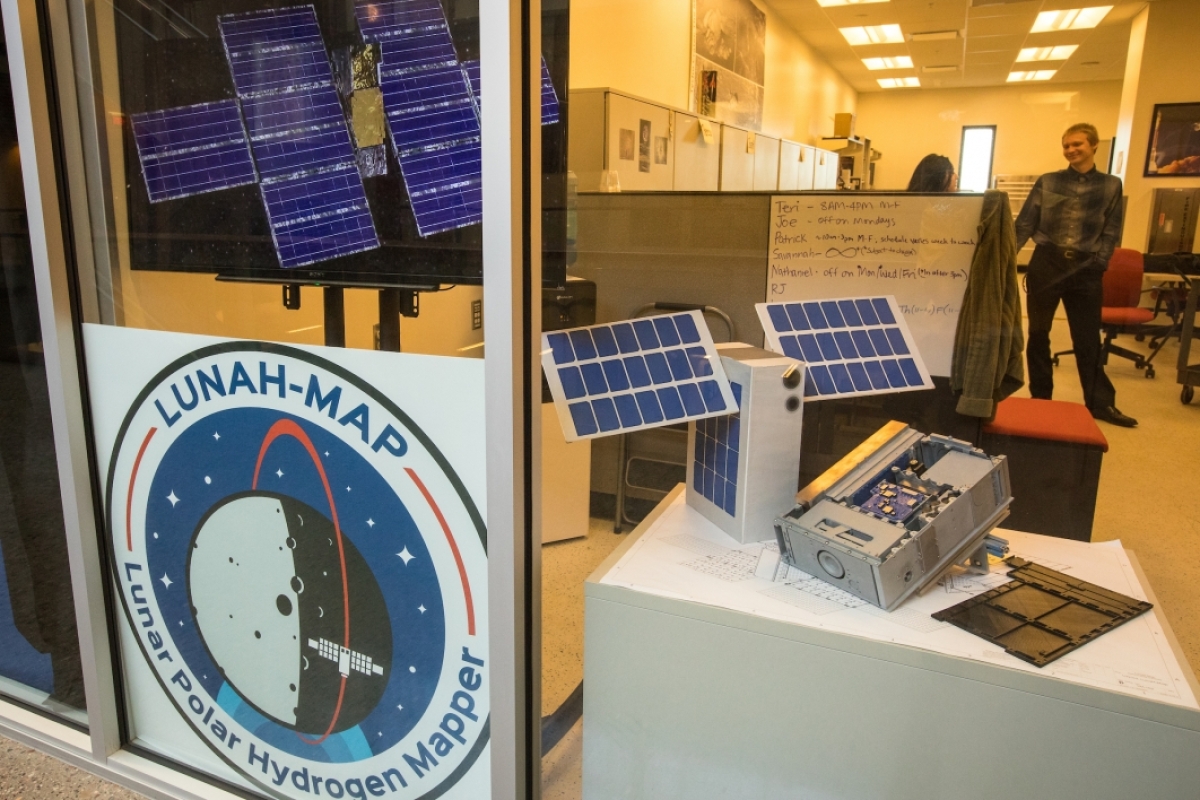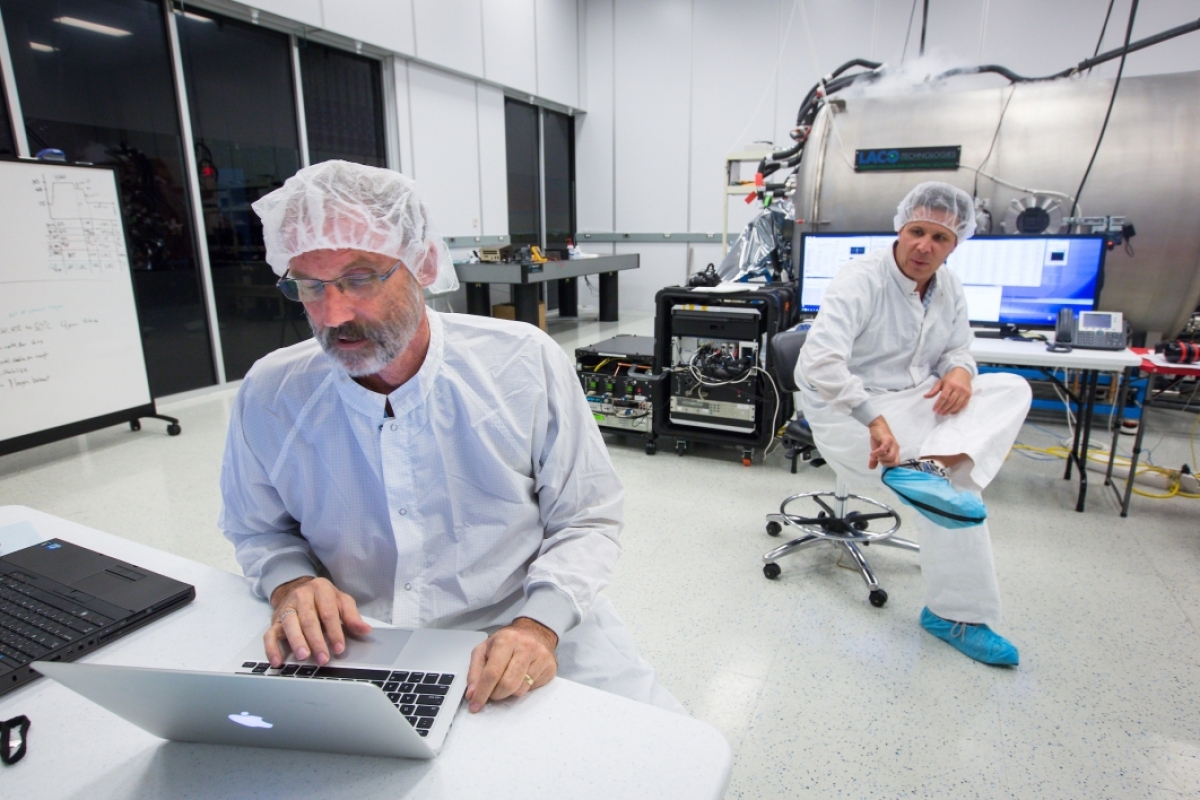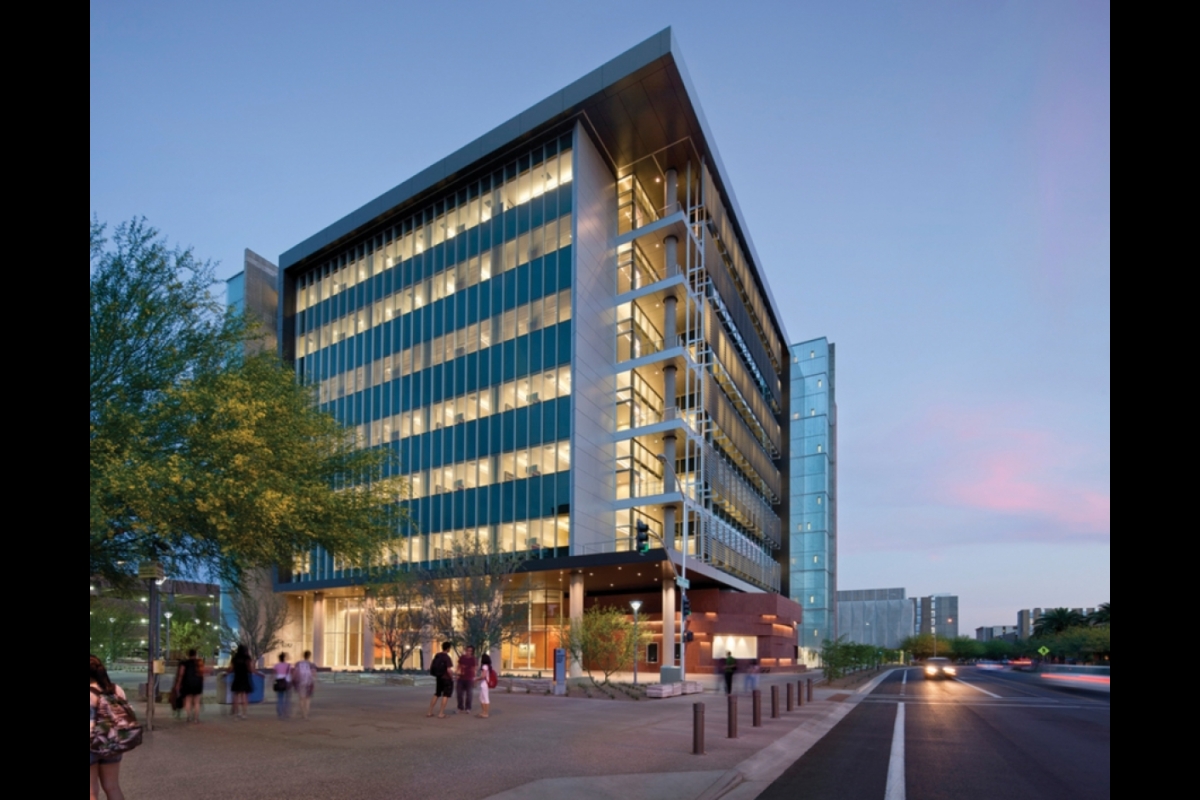The solar system could be Arizona State University’s fifth campus.
Twelve instruments developed at the university are “in flight,” in space parlance: two over the Earth, seven at Mars, one over the moon and two over asteroids.
Construction of the first interplanetary spacecraft built on campus was completed this summer.
Only 30 institutions in the United States can build spacecraft. Only seven build interplanetary“Interplanetary” means anything that leaves Earth’s gravity. Internationally, 40 countries can build spacecraft, but only four can build interplanetary spacecraft. spacecraft.
ASU is one of them.
Twenty-nine members of the faculty and staff have asteroids named after them, including planetary scientist Lindy Elkins-Tanton, who is leading a NASA Discovery mission to an all-metal asteroid, something that’s never been explored before. She is the second woman in NASA history to lead a deep space mission.
Nineteen faculty members are engaged in space missions. Eight instruments — things like cameras, spectrometers and thermal imagers — are in development. One will fly over asteroids, two over Mars, one over the moon and four over Jupiter's moon Europa.
Ten missions are in development. Two will look at exoplanets. One will search for ice on the moon, to be used for water and fuel in off-world exploration. Five telescopes will peer at star formation, more than 300 million galaxies, and dust clouds where stars are forming, among other celestial mysteries. One mission may answer the ultimate scientific question by discovering life off Earth, in a liquid ocean deep below an icy crust on one of Jupiter’s moons. One will explore the all-metal asteroid Psyche.
Graphic by Alex Cabrera/Media Relations & Strategic Communications
These aren’t the university’s first outings by a long shot, however.
ASU has played a role in 25 missions to eight planets, three asteroids, two moons and the sun.
“We are one of the big boys, so to speak, providing so many services and needs, and supporting NASA in so many ways, and (connecting) personally person-to-person on so many different levels,” Elkins-Tanton (Asteroid (8252) Elkins-Tanton) said. “And, you know, that's how business gets done in this world. It's the people who know you and who you know, and who can you call on when you need help or who calls on you when they need help.”
The School of Earth and Space Exploration was created in 2006. As an institution however, ASU’s space program started much longer ago.
This is the story of how a humble geology program grew into a powerhouse of space exploration. It began with a meteorite-obsessed geologist, the Apollo moon landings, a cranky dean and two battered filing cabinets.
Meteorite man
In the early 1960s, the university asked geologist Carleton Moore to study meteorites. He became absolutely hooked, to the point where he would skip lunch in favor of spending more time on the microscope. Moore purchased a collection of 700 meteorites in 1961, which became the basis for the Center for Meteorite Studies, now the largest university collection in the world.
Moore is a celebrity in the meteorite world. When he appears at the Tucson Gem and Mineral Show, he is mobbed like a rock star.
In 1967, Moore (Asteroid (5046) Carletonmoore) was one of the first people asked by NASA to analyze rocks and dust brought back from the moon. He taught on the weekdays and NASA flew him to Texas on the weekends. In 1977, Moore hired a scientist named Ron Greeley.
Greeley was a pioneer in planetary geology.
Rocks and fighter jocks
Greeley (Asteroid (30785) Greeley) helped select landing sites for the Apollo missions and assisted in geologic training for astronauts.
Back in the Apollo days, science was incidental to missions. Engineers — who just wanted to put boots on the moon — frequently clashed with scientists, who wanted to do at least a few things as long as we were going all that way.
One famous story illustrating the rift centered around a geologist who suggested a rock hammer be included in an astronaut’s tool bag. “But we took one of those on the last mission!” an engineer exploded.
Early astronauts tended to be fighter jocks who weren’t much interested in rocks either. Greeley succeeded in educating them to be more sophisticated than describing rocks as big or little, and how to differentiate between an interesting rock and a more prosaic sample.
“He was trying to get them to think about the geology and the rocks and what to look for when they got to the moon,” ASU Professor Phil Christensen said. “If you listen to the transcripts of those astronauts, Ron and others who trained them did a fantastic job. There were a few (astronauts) who were classic test pilots, Navy guys on an adventure and, 'Oh, I picked up a few rocks.' Most of them did a good job.”
The Ron Greeley Center for Planetary Studies at ASU is one of 17 regional sites NASA has designated to archive images for educational and scientific use.
The wunderkind
If Greeley and Moore were the founding fathers of ASU’s space program, Christensen is the founder of what the program has become.
The director of the Mars Space Flight Facility in the School of Earth and Space Exploration, Christensen is also a Regents ProfessorRegents professors are top tenured faculty who have made significant contributions to their field. of geological sciences. He is a planetary geologist and an "accidental" engineer. He has three instruments in flight, three in development, and knows the surface of Mars like the inside of his house.
Lindy Elkins-Tanton and Phil Christensen at a School of Earth and Space Exploration event. Photo courtesy Arizona State University
Back in 1981, Greeley hired the young postdoc who was starting to get involved in space missions. Christensen won a big NASA grant to put an instrument on one of the Mars orbiters.
Greeley was a brilliant field geologist and planetary scientist, but he wasn’t an instrument guy, Christensen said.
“Ron was a pioneer in looking at the data that came back from these probes, looking at images of the moon and Mars and analyzing them, thinking about them,” he said. “He had no interest in building the instruments, building the cameras, building the spectrometers. … He was on the team, he had access to the data, he was a leader in the field, but he was mostly looking at data that existed and doing the usual science. That’s what ASU did. They didn’t build anything.”
When Christensen (Asteroid (90388) Philchristensen) won a huge contract to build an instrument, you would expect people to have jumped for joy.
Quite the opposite happened.
What are you thinking?
When the first proposal was selected, a dean called Christensen into his office. He thought he was going to be congratulated.
“He says, ‘Close the door. What in the hell are you thinking?’” Christensen said. “‘Do you have any idea how difficult you’ve made my job? We don’t have the ability to do this. We can’t manage contracts like that. I don’t have any space to put you. You have no idea how difficult you’ve made my job.’ Needless to say that dean isn’t at ASU any more.”’
Christensen asked an associate dean for office space.
“He said, 'Well, there’s a couple of filing cabinets you can have.’ They just didn’t get it. We had this 10, 20 million dollar contract. It was the biggest contract ASU had ever done. They had no idea how to do it. They had no idea how to deal with an aerospace company. So to go from someone offering me two file cabinets to (the current space program and state of the art facilities) … there’s been a lot of changes at this university. It’s been really amazing to watch this grow.”
Jim Bell is a planetary scientist in the School of Earth and Space Exploration. He has roles on three missions currently in flight, including the camera on the Curiosity rover which has been crawling around Mars for the past eight years, and five other instruments and missions in development. Next month his latest camera will launch from Cape Canaveral on Perseverance, NASA’s newest Mars rover. He is also director of the New Space Initiative at ASU.
The latter is a program that connects students and faculty doing space-related work with outside entities doing the same thing. They range “from SpaceX to a couple of teenagers in a garage,” Bell said. “Where do they need our help? Can you do a mission for 1% of the cost of a big NASA mission?”
Until now, ASU’s space program has revolved around making instruments, which are snapped up by NASA. ASU faculty have been involved with all of NASA’s robotic missions.
“NASA knows us scientifically, but also from an engineering standpoint,” said Bell (Asteroid (8146) Jimbell), who has built several cameras for the agency.
Jim Bell working in a lab. Photo courtesy Arizona State University
And that is because of Christensen and Greeley.
“Those two guys were part of the bedrock foundation of the NASA work here at ASU,” Bell said. “Oh man. That's a great story. Greeley and Moore are the guys who really got ASU on the map in terms of planetary science and meteorites studies, going back to the '60s. They were able to attract great people and get federal funding and grow a great group … they were able to create pockets of excellence around space and space science and commissions, robotic missions, sample analysis, et cetera. Greeley was able to attract Phil Christensen who got even deeper involved and got some real instrument wins for the university. Good people attract other good people to their orbit.”
How to woo NASA
In the early 1980s, NASA picked the University of Arizona to run a Mars mission. The university asked Christensen if he could build an instrument for it. At the same time, Raytheon shut down the Santa Barbara facility where Christensen had been working. Three or four of his colleagues became available. He thought if they came in, and ASU helped out, an instrument could be built at ASU. The instrument they wanted was very similar to one they had already built.
“It was a perfect storm,” Christensen said. “We were one instrument that was part of a bigger project. It wasn’t a huge risk to NASA to pick the UofA to run this mission and one of the instruments will be built at ASU. It was very similar to what we’d built before. And ASU said, ‘We’ll build this fancy new facility.’ … It was fortuitous that everything came together just right."
They worked their tails off for five years.
“This was a one-shot deal,” Christensen said. “Reputation works both ways. If we screw this up, they’re never going to talk to ASU again. Fifteen people on this project took that really seriously. Not just their careers; ASU had spent a lot of money on this building and these facilities. There was a lot riding on us succeeding. People took a lot of pride in this succeeding. And it did.”
The campus where spacecraft are built
Before then, ASU had no place to build instruments or spacecraft.
“Now we can build a NASA flight-quality instrument in this building,” he said. “Ten years ago we would have laughed: ‘We can’t do that. We don’t have the facilities, the people, the credibility.’ But we’ve done it. And now because of that people are coming to me to build them instruments for Europa and other missions. Jim Bell can say we can build and test cameras here. We have new faculty coming in. Ten years from now there will be several people building instruments in this building.”
Now instruments, satellites and spacecraft are built on campus. The LunaH-Map mission is entirely ASU’s. It was developed, designed and built here.
“A NASA mission is 90% about the process,” Christensen said. “How do you do it? How do you make it work? All things you have to do, all the people working together, keeping them together, keeping them from killing each other — to me that’s half the fun. … Within NASA, like a lot of other places, it’s all about reputation. Can you do it? Once you can, that’s a huge step. Suddenly you’re building more, and people come because of that. It sort of mushrooms.”
Clean rooms
The university’s physical investment in its space program has come a long way from two battered filing cabinets.
The 300,000-square-foot Interdisciplinary Science and Technology Building IV opened in 2012. It boasts labs, clean rooms, offices, high bays, a 250-seat auditorium and one of two mission operations centers on campus.
“My colleagues at any other institutions come here and they’re jealous,” Christensen said. Jet Propulsion Lab (JPL) delegations have visited and muttered they don’t have a facility that nice.
“It takes money to make money,” Christensen said. “You build a facility like this, it pays for itself. NASA does not want you building stuff out of spit and baling wire. When they come here and see this, they say, ‘You guys are for real.’”
The clean rooms in the space building are about the size of a small high school gym. It has the usual desks, monitors and chairs. What isn’t usual are the two vacuum chambers, one the size of a packing crate and the other about the size of a Volkswagen bus. They’re used to simulate space conditions. The lab team can crank all the oxygen out of the chamber, drop the temperature down to absolute zero (0 degrees Kelvin), and see how what they’ve built stands up to space conditions.
“You turn it into outer space,” Bell said. “It’s pretty rare for a college campus (to be able to test instruments in that environment). Only a handful of campuses around the country have that capability. Typically you only find that in NASA centers and big aerospace companies.”
They put machines inside the vacuum chambers, thrown in a bunch of dust and rocks, and crank the temperature up to see how they fared. (If you were put inside, your eyeballs would pop, the blood in your veins would boil, and eventually you’d boil away. Outer space is a tough place.)
It’s not uncommon to come in to the clean rooms at 7 a.m. on a Saturday morning and find grad students working on projects. About 15 to 20 people are working on all aspects of design and development at any given time.
No stove piping
The School of Earth and Space Exploration is not a conventional aerospace environment. A scientist can walk down the hall, tell an engineer he needs to get data from somewhere really nasty and inaccessible, and the engineer can figure out how to make a machine that will go there, survive, and get the data home.
That’s rare, Bell said.
“The reason that I left my previous university was because I couldn't do this kind of stuff there. It was the typical U.S. university of systems. You had the engineers over in the college of engineering over on that side of campus and the scientists over in the arts and sciences department on this side of campus, and they're physically separated and they're bureaucratically separated, and the students can't take classes — one of the other — and get the credit that they need for their graduation. That's been the typical system. They call it stove piping. ASU has kind of destroyed a lot of those boundaries, and we're seeing other schools do this as well. And seeing them learn from this kind of a model of integrating and cross discipline and transdisciplinarity and lots of collaboration and mixing of expertise within the same academic units, that wasn't possible where I was before. … So far the experiment’s working great. … I mean, this is really what employers are looking for and looking for people who can work on a team, understand other disciplines, that type of thing.”
It’s a far cry from the '60s, when engineers fought scientists. Now they are in the same building, unseparated by distance or bureaucratic walls.
“The cutting edge of space exploration is that it’s not good enough to just tell somebody to go build a camera and show up and use it later,” Bell said. “You really have to have your goals in mind while that instrument is on paper. You really have to dive in and become an optics expert. I’ve got to work with optics experts and electrical engineers and all that because I want to make a certain measurement to a certain level of accuracy in a certain environment. The more I can partner with people who understand the engineering and the guts of the electronics, the better my experiments will be. Building those people into the department that is my home at the university is just incredibly efficient and wonderful.”
What it takes to go to space
Some 40 years after Greeley’s time, NASA now comes to ASU’s door.
“When you do things well — really, really well — people notice.” Christensen said. “It’s not just me. (They say), ‘Oh, ASU can build those instruments.’ And that flows over to Jim and Craig (Hardgrove, principal investigator on the moon CubeSat mission) and Lindy (Elkins-Tanton, former school director). We’ve built ASU’s reputation.”
The Mars Rover helped a lot too, he said.
“Being world leaders in something as visible as exploring Mars got a lot of attention to ASU that leveraged a lot of things going on here now,” Christensen said. “A lot of science is fabulous but, I’m sorry, landing on Mars is not the same as discovering a new type of plastic for Coke bottles — OK, great. Landing on Mars gets you on the cover of magazines.”
In the current era of space exploration, NASA and the big aerospace legacy outfits like Lockheed Martin aren’t the only players any more, pointed out Meenakshi Wadhwa, director of the School of Earth and Space Exploration. New Space companies — many of which are in Arizona and hire the school's grads— have a lot of skin in the game.
“There are also new technologies and different types of platforms, such as CubeSats and SmallSats, that are allowing cheaper and more efficient ways for us to explore our solar system and beyond,” said Wadhwa (Asteroid (8356) Wadhwa), also a science team member on one mission in flight. “I see ASU leading the charge in many such areas, and creating innovative new pathways for space exploration that will involve the participation of people that have traditionally not been so well represented in this grand endeavor.”
Taking on a mission like Psyche requires a lot of commitment from the home institution, Elkins-Tanton said. You need project managers, course releases for faculty involved, physical lab and office space.
“It really takes the determination of the whole organization to make something like this work,” she said. “The truth is we need people from every discipline to make space exploration successful. … A place where a lot of universities can't really step up is the need for really special financial support, budgeting, forecasting and reporting. And of course just handling the money coming in and going out, and tracking, and the needs for a really big mission are often completely beyond anything else that a university has done in terms of scale and specificity of requirements. And so you need the whole university to want to support the endeavor.”
One big advantage ASU has — and an area that Elkins-Tanton feels has led to the university’s space success — is teamwork.
“To be successful in these big endeavors, especially in space exploration, you need the faculty talent, of course, but that's where people's thinking usually begins and ends in academia,” she said. “If you hire the right people who are doing the exciting stuff, then it will all happen. But one of the big differences between space exploration and other things that we do in the university is that space exploration is done in teams. And it's done in big teams (with) a huge amount of pressure and absolute requirement for incredible quality and rigor. And doing those things in teams is not something that is taught very often in academia. In fact, we're kind of brought up to be separate — individual heroes of our little fields.”
Without teamwork, you don’t go to space, she said.
“One of the things that ASU has got going for it is … you can start right here at home with putting together some people who are going to be helpful and supportive and try to see if they can add their ideas, to make the central idea bigger and not necessarily make it just about themselves. And you can take that core capability outside and you can partner up with your NASA centers and other universities and other people. But without the willingness of people to put the greater good of the whole or the team or the exploration or the goal above the greater good for themselves? You'll never get to space. And so that's one of the things that ASU has that's special.”
Students in space
While the faculty lead the charge into the solar system, students benefit. At ASU, undergrads don’t hear, “That’s not for you.” When students work on projects, they’re not models or games or toys. They’re real NASA missions.
“Here at ASU, we pride ourselves in preparing our students not only for the jobs today but also for the jobs of the future,” Wadhwa said. “Part of this preparation involves giving the students the opportunity to work on real world problems, and on real spacecraft missions that will be exploring our solar system and beyond. It also gives our students the opportunity to learn some of the key job skills that many employers look for, such as how to work well as part of a team.”
”
Last November, the first fully student-led CubeSat (a satellite about the size of a big shoebox) was launched from the International Space Station. About 100 students and faculty members from four schools within the university played a role in either developing or promoting the Phoenix CubeSat.
Phoenix CubeSat launching from the ISS.
A $200,000 grant provided by NASA's Undergraduate Student Instrument Project (USIP), and the NASA Space Grant Consortium as an Educational Flight Opportunity gave undergrads the opportunity to pursue a hands-on project that helped prepare them for careers in the space industry while benefitting NASA. They learned spacecraft development, interdisciplinary communication, project management and how to develop a scientific objective from the ground up.
About 550 students have participated in the Psyche mission in some way, Elkins-Tanton said.
“I think that that changes their lives,” she said. “It gives them a little window into something else. It connects them to a larger world, to add to all the other experiences they have in their lives. And that to me is something very important and, and really worth spreading the word about.”
Touching a piece of machinery that will fly in space is a powerful experience. Making that happen is a powerful experience for faculty too.
“There have to be people along the way to give them footholds and handholds,” Elkins-Tanton said. “And as a university, we can do that now. And that is, ah, that's lovely for me to see. … We get messages from students all the time saying, 'It's just my lifelong dream to work with NASA. How do I do that?' And to be able to be one of those places where students can come in and they can participate in this boldest of all human explorations, that seems like a very worthwhile way for us to be spending our time and resources to make that accessible.”
Students in the Space Works 1 class learn exactly what space companies like Orbital ATK and Paragon and SpaceX want in employees. Can they work in a team? Do they know what a milestone is? What it means to stick to a schedule? Planetary science and aerospace engineering classes teach a lot, but not everything.
Sheri Klug Boonstra has more than two decades of experience in creating and implementing national NASA STEM education pipeline programs stretching from pre-college to workforce. NASA and industry have told her exactly what they want in new hires.
“They’ll be able to take their degree and work directly in the space industry,” she said. “We’re mapping our activities in this class to what industry and NASA has been telling us, ‘These are the top things we need them to be good at.’ Those are the things that are embedded in this course.”
She co-instructs the class with Christensen.
“The stuff they learn in classes is fantastic, but applying that in a real-world kind of way is what we’re trying to do here,” he said. “What’s a critical design review? What’s an end item data package? I want the students that come out of here to show up at JPL and say, ‘Yeah, I know what that is. I’ve done that. I know exactly what goes into one of these reviews. I know what it means to be the program manager. I know what it means to be the manufacturing engineer.' … How do real engineers go about their daily jobs?”
The degree to which students are involved with the school’s missions and projects has been spotlighted by the government.
“Our student collaborations are so innovative and so large, so much larger than what other space missions have done in terms of the number of students involved that NASA regularly holds us up as the exemplar of what we could do with our student collaborations and of all the things we're doing on the mission,” Elkins-Tanton said.
One of the newest programs in the school is a satellite command and control operations certificate. ASU has a ground station, but the capabilities are still being developed. They can communicate with satellites in Earth orbit a bit, but it’s all run through NASA’s Deep Space Network via JPL.
“We're certainly training the kinds of future engineers, scientists, managers and administrators who are going to be working with robotics and who are going to be doing a lot of the ground support kind of activities for human and robotic exploration in the future,” Bell said. “Absolutely.”
And everyone is welcome on the ride. Come on along to space, Wadhwa said.
“At ASU, our core values are about innovation and inclusion,” she said. “In the School of Earth and Space Exploration, our goals for space exploration are also about being innovative and entrepreneurial, and about including everyone who wants to be involved in the excitement and scientific discovery."
Top photo courtesy Pexels.com.
More Science and technology

ASU-led space telescope is ready to fly
The Star Planet Activity Research CubeSat, or SPARCS, a small space telescope that will monitor the flares and sunspot activity of low-mass stars, has now passed its pre-shipment review by NASA.…

ASU at the heart of the state's revitalized microelectronics industry
A stronger local economy, more reliable technology, and a future where our computers and devices do the impossible: that’s the transformation ASU is driving through its microelectronics research…

Breakthrough copper alloy achieves unprecedented high-temperature performance
A team of researchers from Arizona State University, the U.S. Army Research Laboratory, Lehigh University and Louisiana State University has developed a groundbreaking high-temperature copper alloy…


